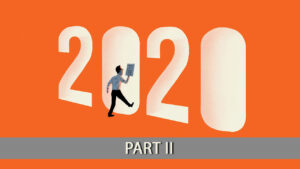
Normally when we talk about trends and the future, we are actually thinking more about the present. The reason we are keen on understanding trends is because we want to know how they will affect our current business and how we should act now to avoid being outdated.
Here are a few key trends that will affect the security industry in 2020, and probably even longer into the future. Here the next 4 influential trends of 2020 are anlysed.
4. Ultra-high definition

People want to see more and see with more clarity; thus pursuing ever higher image resolution has been a key driving force in the development of security industry technology. After the HD era, the Ultra High Definition (UHD) era will be the natural next step.
UHD used to mean “expensive cost”, but now UHD is benefiting from improvements in transmission and encoding technologies. It is becoming more and more cost-effective for large-scale use in the security industry, from entry levels to the top.
With greater bandwidth and lower latency transmission technology, the smooth transmission of UHD images is becoming possible, and widespread adoption of 4K and 8K resolution cameras will meet real opportunities.
Furthermore, continuously optimized encoding technology – which is vastly decreasing the bitrate of video – is another stimulus for UHD applications in the security industry. As the bitrate of recorded footage is greatly reduced, bandwidth and storage costs are reduced as well.
5. Visibility, any time and any condition

Most security incidents happen at night, but images and footage from conventional security cameras may easily lose colors and critical details in ultra-low light environments. Low light imaging technologies have become more and more popular in the security industry, enhancing the visibility of objects for identifying details at any time and in any condition.
Another important innovation is thermal imaging, which can detect the heat information of any object with a temperature above absolute zero. Taking advantage of heat zone imaging, thermal imaging technology allows cameras to “see” in low-visibility conditions, such as fog, smog, rain, and snow – even at night. And thermal cameras have huge potentials in various applications, like perimeter defense, fire detection and temperature measurement.
6. Moving to the cloud

As we mentioned at the beginning, more security devices, including cameras, are being connected over the Internet, making them parts of the IoT world. Thus, “moving to the cloud” has been a focus for the security industry – especially for video surveillance operations. Why are people enthusiastic about the cloud? It’s because cloud services can bring vast benefits in efficiency, flexibility, cost-effectiveness, and security.
Among security operations, video surveillance as a Service (VSaaS) has been a major trend in the security industry as it is an ideal choice for small and medium-sized businesses to move their video-based security systems to the cloud. It is a technology to host the hardware and software of security operations in the cloud, so that users can access their IP cameras and IoT devices and check video footage or alarm linkage from anywhere. Since no on-site server installation and system configuration is needed, it is often more convenient than traditional video surveillance solutions. On the cloud, users can distribute costs over a contract term and pay for exactly and only the services that are used.
For enterprises running chain stores, demands on VSaaS are increasing greatly. Moving video surveillance services to the cloud, these businesses can quickly and economically centralize their security operations and remotely check the status of their stores.
To greet the “moving to the cloud” trend, security system integrators are also taking hold of VSaaS as it is a good chance to strengthen their business models. With VSaaS, system integrators are able to provide services for their clients using the cloud – such as system checks and remote maintenance – and consistently scale their business with efficiency.
7. Higher demands on cybersecurity

With millions of security devices being connected in IoT, security systems are evolving from single and isolated to open and connected. People are getting more and more concerned about the security of their data and privacy, and accordingly have set higher demands for the security industry on cybersecurity.
To help minimize the risk of security breaches, a multi-layered approach – including network, application, and device layering – that addresses a full range of cybersecurity threats concurrently will be demanded and expected by security organizations and IT departments. Security manufacturers, will also have to cover the security of their products throughout the whole lifecycle.
Final words
Just as 2020 is the beginning of a new decade, we expect to see a new decade of innovation in technologies and applications. Along with the prominent security industry trends mentioned above, other trends such as 5G, big data, smart enterprise operations, and stricter data protection regulations like EU’s GDPR, might also greatly affect the industry in the 2020s.
Source: a&s Magazine



































































